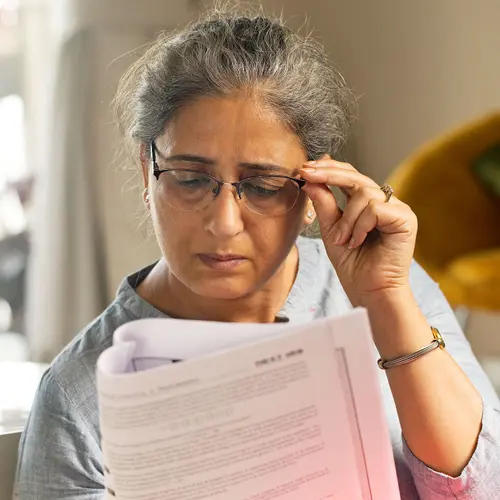Close to 20 million Americans live with age-related macular degeneration (AMD). The most common type is dry AMD, which can progress slowly over time. It can progress to wet AMD -- a more advanced and damaging disease that can cause a sudden loss of vision.
If you’re a caregiver for someone with AMD, your goal is to support your loved one in their day-to-day life. On any given day, you may have to drive them to a doctor’s appointment, make sure they’re staying active, and pick up clutter in their living space. It can be demanding, but there are ways to make your job easier while caring for your loved one’s health and safety.
Make Medical Appointments a Priority
Taking your loved one to their eye doctor appointments is an important part of your caregiving role. Your loved one’s eye doctor may recommend shots every 4 to 6 weeks. Or they may want to check for changes and modify treatment plans on a regular basis.
Regardless of the reason, it’s crucial to make each doctor visit as scheduled. Even one missed appointment could lead to further vision loss or complications. One study suggests that patients with wet AMD who didn’t miss appointments had the best visual outcomes.
Adopt Technology Tools
These can help with daily activities such as reading, cooking, and searching the internet. You can help your loved one try different devices and learn how to use them correctly. If a device requires a prescription or is covered by insurance, you may need to help with that as well.
A variety of assistive technologies can help your loved one’s quality of life:
Magnifiers. These handy tools come in many sizes, from round and small enough to carry in your pocket to rectangular and large enough to lay over a newspaper. They’re available in different strengths and many come with built-in accessories like lights and clamps.
Voice tech aids. You probably know about audio books and speech-to-text programs. But there are many more voice-supported products such as cookbooks, dictionaries, and calculators, to name a few.
Telescopes. Monoculars and binoculars can help your loved one see faraway objects. Some attach to regular eyeglasses while others are handheld.
High-powered eyeglass lenses. Glasses with high-powered lenses have many benefits. They provide magnification for simple tasks like reading the mail, price tags, and menus. They also reduce glare, provide high color contrast, and reposition images to the wearer’s visual field.
Computertechnology. Look into programs that can convert text to speech on your loved one’s computer. Or learn how to connect their computer to a TV to enlarge the display.
Create a Safe Home Environment
As your loved one adjusts to life with low vision, you may need to make some adjustments around their home. You can support your loved one by making the following changes:
Kitchen. Use non-slip surfaces on the floor like rubber mats. Paint cabinet doors with bright, contrasting colors. Install bright, under-counter task lighting.
Bathroom. Plug in bright nightlights. Replace a white toilet seat with a contrasting color. Use brightly colored towels. Install safety bars in the shower and bathtub.
Living room and bedroom. Arrange furniture to create wide pathways and a smooth flow of traffic. Replace low-watt lightbulbs with higher wattage. Replace light switch plates with new ones in contrasting colors to the walls.
Windows. Install window coverings that are easy to adjust. They will give your loved one control over the amount of light and glare they let in.
Steps. Add contrast to steps with colorful tape strips along the edge or with paint or carpeted stair covers. Install a hand railing for a flight of stairs.
Clutter and safety. Secure electrical cords. Remember to push in chairs in your dining area or home office. Use cleaning products on floors that won’t make them slippery. Secure rug corners or remove throw rugs completely.
Help Them Stay Healthy Physically and Mentally
- Eat healthy meals rich in fruit, vegetables, whole grains, and lean proteins.
- Visit a mental health provider or primary care doctor if they show signs of depression or anxiety.
- Check their vision daily using an Amsler grid to look for changes.
- Get regular blood pressure screenings (high blood pressure raises the risk of AMD progression).
Help Them Stay Active
It’s important for people who are visually impaired to remain physically, mentally, and socially active. It can be a challenge to live with low vision. People who have AMD may have feelings of depression or anxiety when they’re less able to do things on their own and feel less independent. It may be harder for them to get out, which can lead to feelings of isolation and loneliness.
To help your loved one stay active and socially connected, try to do these things with them or arrange for other friends and family to help:
- Go on outings such as concerts or nature walks.
- Engage in social activities with family members and friends.
- Join a low-vision center or find a low-vision therapist.
- Take exercise classes like yoga or stationary cycling.
Reach Out to AMD Resources
To learn more about AMD, visit the BrightFocus Foundation or the American Macular Degeneration Foundation online. These organizations publish the latest research and treatments, offer community support, and list additional tech tools for AMD.

